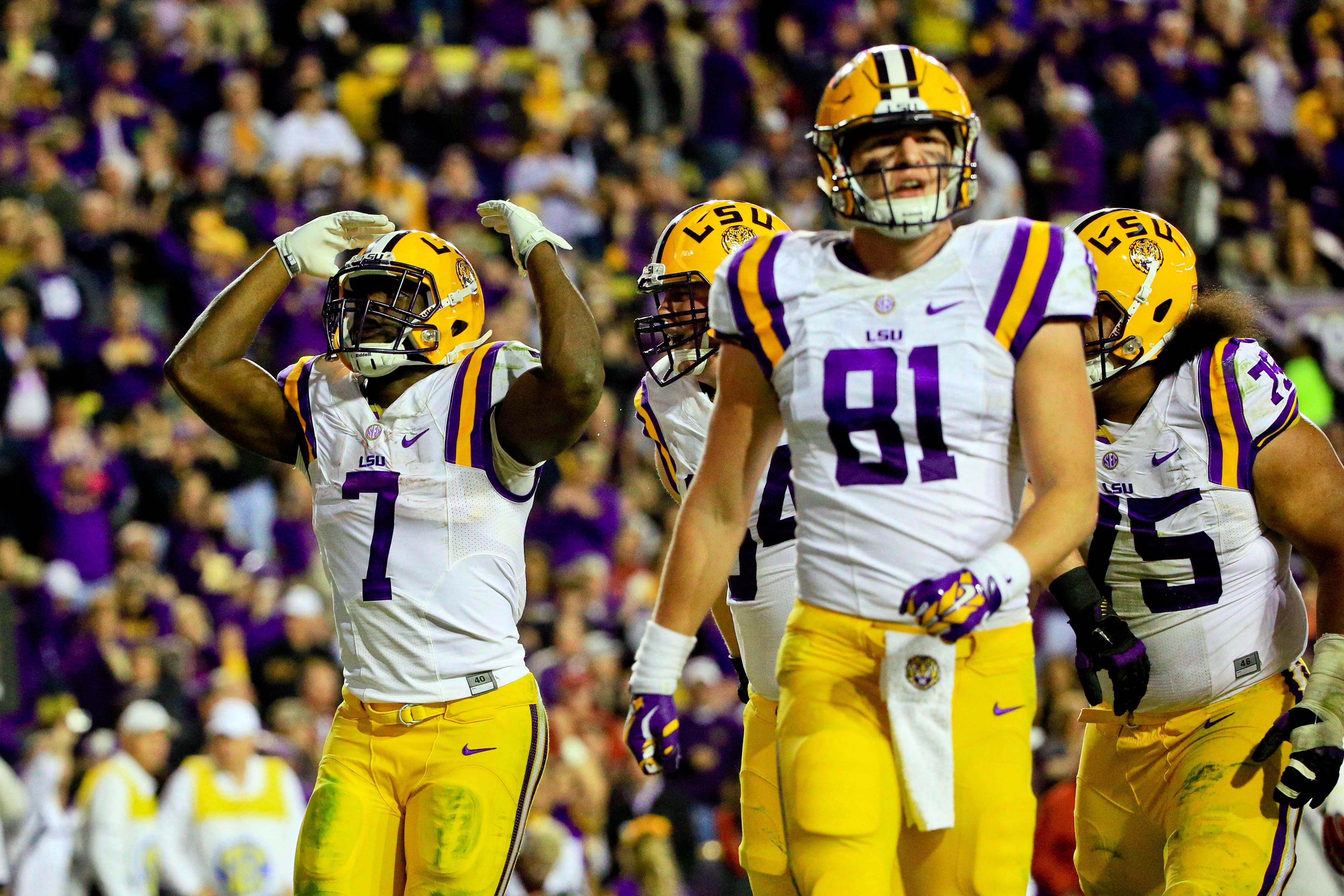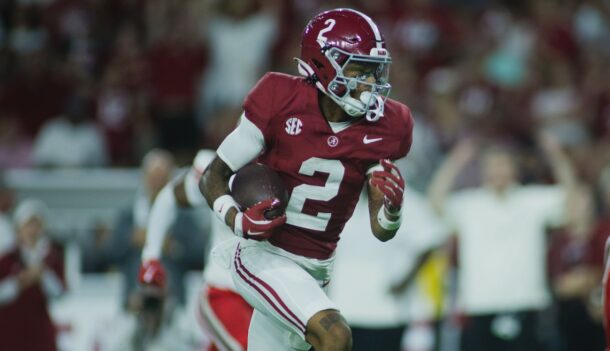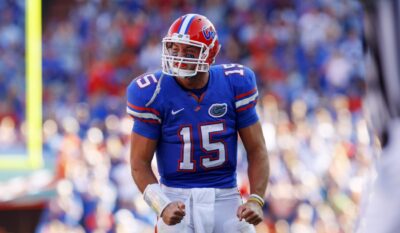
Those striking, proud and pretty home white jerseys flash before you on fall Saturday nights in Death Valley.
To the loyal fan’s eye, they are a fascination and an institution. And they are as much of a tradition as the players who have donned them over the decades, making LSU football a proud religion, a powerhouse some of the time and a factor nearly all of it.
And, really, those white jerseys wouldn’t be so steeped in lore had the Tigers not produced so many memorable victories while wearing them.
College Football's Best Historical Uniforms: #LSU's Home White Jerseys: http://t.co/ImkuLvw5xP pic.twitter.com/7cWJOIFm3B
— TigerDroppings (@TigerDroppings) May 26, 2015
If you a serious LSU football fan — and, honestly, what other kind is there? — you come to home games and cheer the team in white (unless it’s a non-SEC game that isn’t the home opener, but we’ll get to that later).
Southern Living listed “8 Fun Facts Every LSU Fan Should Know.” No. 5 on that very important checklist reads:
“5) LSU Tigers always wear white football jerseys at both home and away games, bending the NCAA rule that requires home teams to dress in color, with the visiting team in white.”
Battling NCAA for right to wear white
The Legend of the White Jerseys being fifth on that hallowed list tells one all he or she needs to know about how intertwined the white threads are with the victories the men who wore them produced. They are part of the Death Valley experience, like not being able to hear yourself think for most of 3 1/2 hours and, most of the time at least, not letting the opponent breathe on the way to another suffocating victory.
Go to LSUsports.net and you’ll find five pages devoted to the school’s rich football traditions, and you better believe a portion of that is dedicated to those home whites, somewhere in between the “Billy Cannon Run” and the Golden Band from Tigerland.
While most of college football dons the dark jerseys at home (Georgia Tech is another exception), LSU has dared to be a little different. It started in 1958 when Tigers coach Paul Dietzel decided that his team should wear white at home. When LSU won the national championship that year, well, the white jerseys were destined for longevity in Baton Rouge.
But in 1983, it looked like the tradition would come crashing down when new NCAA rules prohibited home teams from wearing white.
So LSU was forced to don its purple jerseys (blasphemy in Baton Rouge) at home between 1983 and ’94. Despite winning SEC titles in 1986 and ’88, passionate Tigers fans often complained the purple threads were bad luck and that an important Bayou football tradition had been pushed to the side.
In 1993, coach Curley Hallman asked the NCAA if LSU could start wearing the white jerseys at home again during LSU football’s centennial. He was denied.
It looked like The Legend of the White Jerseys was just that — a legendary piece of LSU football history to be viewed in pictures but never to be played out in a live game again. But in 1995, new coach Gerry DiNardo saved this fading memory.
DiNardo did everything possible to restore the lore of the white jerseys. He met with each member of the NCAA Football Rules Committee, and his persistence paid off. The NCAA finally said “yes,” and LSU again was allowed to wear white at home to start that ’95 season.
As if from the sheets of a movie script, an unranked Tigers team beat No. 6 Auburn 12-6 in their first home game with the white uniforms, and all was right in the Bayou again.
@PeterBurnsESPN @SECbooger Here you go, following LSU's 1995 win over Auburn. Found it last week doing prep work. pic.twitter.com/oEsCBU9EwD
— Michael Cauble (@Cauble) September 21, 2015
Home whites key part of Tiger experience
Interestingly, after that 1995 rule change, LSU was only forced to wear its colored jerseys at home twice. Once was in 1996 against Vanderbilt, which was angry at LSU for hiring DiNardo away from the Commodores after the ’94 season.
The Tigers wore gold jerseys for that game (not purple) and won 35-0, playing in front of a crowd that was encouraged to wear white in order to “white out” Vanderbilt.
The Commodores were exercising a stipulation to the ’95 rule change that said visitors must agree to LSU wearing white for conference and non-conference games. In 1997, the SEC softened that stipulation by allowing home teams their choice of jersey color for conference games without approval from the visiting team.
Can't wait to see the battle between LSU and Florida this Saturday in Death Valley! #GeauxTigers #GatorWeek #Rivalry pic.twitter.com/GaFdBYidEK
— Jacob Hester (@JacobHester18) October 14, 2015
The only other time LSU was forced to wear its colored jerseys at home was in 2004, when Oregon State did not want to don its black jerseys because of that suffocating late summer humidity in Louisiana.
So LSU wore its purple unis for the nationally televised game, and the then-defending BCS champion Tigers coached by a guy named Nick Saban pulled out a 22-21 victory in overtime. Ironically, lightning delayed the game for almost an hour and it was played on a sloppy field after a heavy storm moved through.
After the 1995 rule change LSU was forced to wear its colored jerseys on the road just four times, in 1998 and 2000 at Florida, and in 2007 and ’09 at Mississippi State. For LSU fans of history who were keeping score, the Tigers lost both games in Gainesville and won both games in Starkville. In other words, those darn colored jerseys weren’t a total failure.
But the purple or the gold threads will never be the white uniforms.
Decades of dedication were built on loyal Louisiana eyes burning down on those white jerseys from the stands in Baton Rouge. They are such a big deal that a few weeks before the 2007 BCS title game against Ohio State, LSU bothered to announce via its equipment manager that it would be wearing “its traditional white jerseys” at the Superdome after Ohio State chose to wear its home scarlet colors with it getting first choice as the higher-ranked team.
Of course, the Tigers beat the Buckeyes handily to win their third national title, and you just know it was those white jerseys that put the Bayou Bengals over the top.
But LSU doesn’t wear those fabled whites for every home game, even if it seems that way.
The Tigers don them for their home opener and for home SEC games. For non-conference home games other than the home opener, LSU wears purple.
Locker room is ready for @LSUfball tonight. Bringing back the purples. pic.twitter.com/NCnRMolYvO
— LSU Football Equip (@LSUFBEquipment) October 24, 2015
Thus, you might notice those blasphemous purple threads trotted out at Tiger Stadium when whatever non-SEC school comes to Baton Rouge for a likely beating. Call it a new Tiger tradition, started by Saban when he came aboard in 2000, carved out within the framework of the original one that began some 58 years ago under the daring Dietzel.
From LSU’s first championship coach to Saban to Les Miles, with some crucial persistence from DiNardo in between, this jersey nuance was born, celebrated, ripped away, rescued, tweaked and is celebrated once more on fall Saturday nights in Death Valley, or at least the Saturdays you probably remember the most.
Cory Nightingale, a sports copy editor at the Miami Herald, lives for Saturdays. He especially enjoys the pageantry, tradition and history of SEC football.







